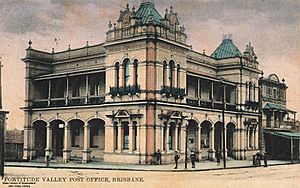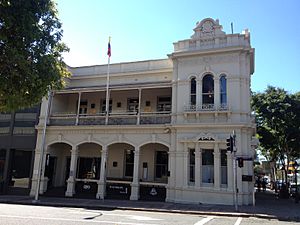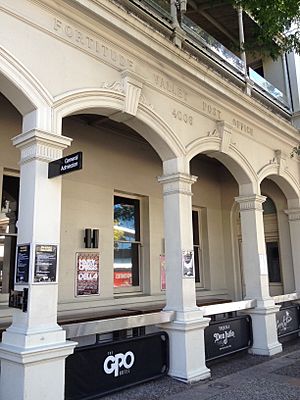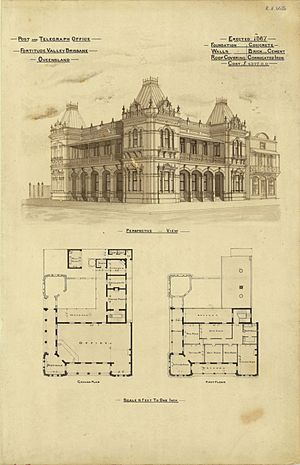Fortitude Valley Post Office facts for kids
Quick facts for kids Fortitude Valley Post Office |
|
|---|---|

Fortitude Valley Post Office, 2017
|
|
| Location | 740 Ann Street, Fortitude Valley, City of Brisbane, Queensland, Australia |
| Design period | 1870s - 1890s (late 19th century) |
| Built | 1887 |
| Architect | Colonial Architect's Office |
| Architectural style(s) | Italianate |
| Official name: Fortitude Valley Post Office (former), Fortitude Valley Post and Telegraph Office | |
| Type | state heritage (built) |
| Designated | 24 January 2003 |
| Reference no. | 600198 |
| Significant period | 1887 (fabric) 1887 – c. 1987 (historical) |
| Significant components | post & telegraph office, residential accommodation – post master's house/quarters |
| Builders | William Ferguson |
| Lua error in Module:Location_map at line 420: attempt to index field 'wikibase' (a nil value). | |
The Fortitude Valley Post Office is a historic building located at 740 Ann Street in Fortitude Valley, Brisbane, Australia. It was once a very important post office. The building was designed by the Colonial Architect's Office and built in 1887 by William Ferguson. It is also known as the Fortitude Valley Post & Telegraph Office. This special building was added to the Queensland Heritage Register on January 24, 2003.
Contents
A Look Back: History of the Post Office
The Fortitude Valley Post Office and Telegraph Office opened in 1887. It was built by William Ferguson for the Queensland Post and Telegraph Department. The building's design came from the Colonial Architect's Office. This office was part of the Department of Public Works.
Experts believe the design was created by either John James Clark or George St Paul Connolly. They were both Colonial Architects during that time. The building shows off the Victorian Italianate architectural style. This style was popular in the late 1800s.
Only ten major post offices in Queensland were built in this style. The Fortitude Valley Post Office stands out because of its fancy front. It is also the only one designed with special mansard roofs (though these were later removed).
Combining Services and Homes
In 1887, the government decided that post and telegraph services should be together. They also wanted homes for postmasters and their families. So, the Fortitude Valley Post Office was designed with two main parts.
The ground floor was for postal and telegraph services. People could access postal services from the corner entrance. Telegraph or parcel services had a separate entrance. The first floor was the postmaster's home. It had living rooms, bedrooms, and a bathroom.
A smaller building at the back held the postmaster's dining room, kitchen, and a servant's room. This design allowed the postmaster to live right where they worked.
Growth and Location Debate
When the post office was built, Fortitude Valley was growing fast. Many businesses and homes were being built. Nearby areas like New Farm and Teneriffe were also expanding.
The opening of the Teneriffe wharves for international ships made the area even busier. This put a lot of pressure on the older postal services. The government bought the land for the new post office in 1884.
However, many local people wanted the post office in a different spot. They thought it should be closer to the main business area. This argument went on for many years. Finally, in 1936, it was decided that no money would be available for a new post office. So, the Ann Street location stayed.
Changes Over Time
After Australia became a federation in 1901, the Australian Government took over the post office. Small changes were made inside in 1909 and 1925. Around this time, the post office also started helping with social security payments.
In 1929, a report said that the Fortitude Valley Post Office was paying out a huge number of pensions each week. It was one of the busiest centers in Australia for this service.
The original mansard roofs were removed sometime before 1949. Around 1950, the postmaster moved out of the first floor. This space was then used for staff facilities.
Major changes happened in 1958. A new staircase was added, and many inside walls were removed. The back service wing was partly rebuilt. In 1970, the rear wing was completely replaced with a larger, two-story building. More changes were made inside the original post office at this time.
In 1975, the Postmaster General's Department was split up. Australia Post took over postal services, and Telecom Australia handled telecommunications. Australia Post made more changes to the building in 1987. They also tried to restore some of its original look. By 2010, the building was being used as the GPO Hotel.
What the Building Looks Like
The Fortitude Valley Post Office is on a fairly flat corner where Ann and Ballow Streets meet. The original building takes up about 40% of the land.
It's a two-story building made of brick, steel, and timber. The outside bricks are covered with a special cement finish. The corners facing Ann and Ballow Streets are very fancy. They have detailed carvings, decorative window frames, and unique shaped tops called pediments.
Stone steps lead up to the ground floor arcades. These are covered walkways with rounded arches. Above the arcades are open verandahs with beautiful cast iron columns and railings.
The original part of the building from 1887 is shaped like a square. Most of its walls are brick covered in plaster. Some of the old timber walls are still on the upper floor. The ceilings are made of wooden boards. The floors are also wooden boards, but they are covered with carpet downstairs and vinyl tiles upstairs.
Some original cedar doors and door frames are still there. Two fireplaces were once on the northern wall, but they have been closed up.
Today, the ground floor has a main entrance area and a large open space. This space is partly divided into three small offices. A strong room, built with thick walls and a metal safe door, is also in this area. The original cedar staircase, now painted, leads to the upper floor.
Upstairs, there are several large rooms. Most of the original dividing walls have been removed. There are also new male and female toilets. All the original cedar French doors on the upper level are still there, but they have been painted over.
Next to the old building is a two-story brick extension built in 1970. This part faces Ballow Street. It holds a large mail room, private mailboxes, and a garage on the ground floor. Upstairs, there's a postman's area and a staff lunch room.
The roof on the old part of the post office is now a single, gently sloping steel roof. The original chimneys are gone. The newer section also has a similar steel roof.
Why It's a Heritage Site
The former Fortitude Valley Post Office was added to the Queensland Heritage Register in 2003. This means it's a very important building that needs to be protected. Here's why:
- Shows Queensland's History: The building helps us understand how post and telegraph services grew in Queensland. It also shows how Fortitude Valley developed during a time of fast growth in business and homes. Its grand size and style show how successful Fortitude Valley was back then.
- A Rare and Special Building: This post office is a rare example of the Victorian Italianate style. It's one of only ten such buildings designed by the Colonial Architect's Office. It's especially unique because it was the only post office in Queensland built with mansard roofs (even though they were later removed).
- Great Design and Craftsmanship: The building's fancy front is considered one of the most detailed of all post offices in Queensland. The different carvings and decorations show amazing skill. It's also interesting because it combined a post office with a home for the postmaster.
- Beautiful and Important to the Area: The building's detailed front is very beautiful. It's one of the few large buildings from the late 1800s left in Fortitude Valley. It helps show what the area looked like a long time ago.
- Strong Community Connection: The Fortitude Valley Post Office was very important to the local community. It provided essential postal and telecommunication services. The debate about its location also shows how much the community cared about it. It also played a big role in giving out social security payments in the early 1900s.





